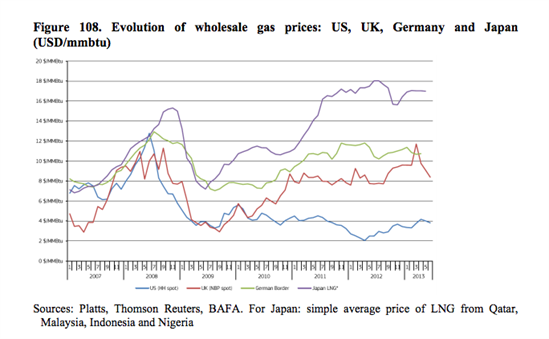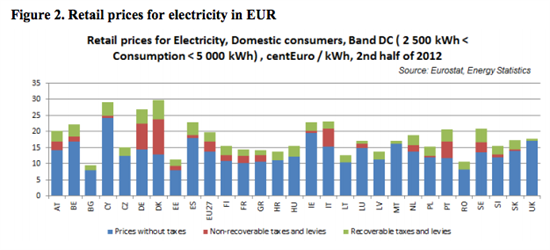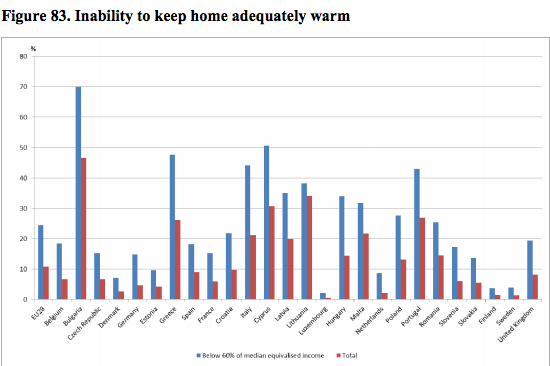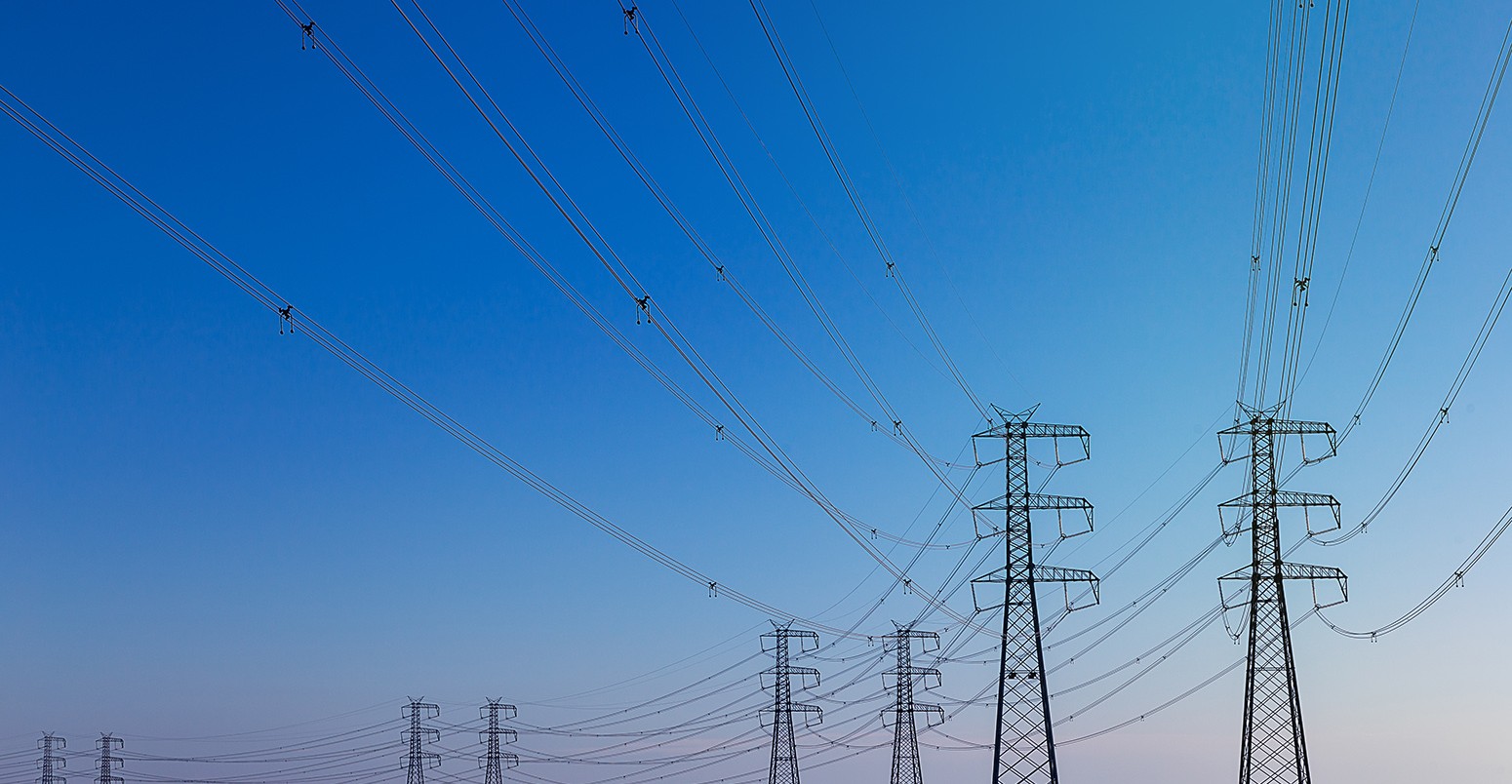
How the cost of energy in the UK compares to other European countries, in five graphs
Robin Webster
01.30.14Robin Webster
30.01.2014 | 11:00amThe cost of energy in the UK is rising, creating concern about the effect on vulnerable households, and prompting calls for government intervention.
But do our European neighbours have even bigger problems? As energy prices increase across the European Union (EU), consumers in some member states are paying considerably more for their energy than us, according to a European Commission study released last week.
We’ve summarised how the UK is doing on the costs of energy, from gas and electricity prices, to subsidies for energy, to fuel poverty and energy efficiency.
Gas – the UK pays less than Japan, but more than the USA
Energy prices are rising as a result of increased demand, changes in trading patterns, and a link between gas and rising oil prices.
These have pushed up the price of gas globally since 2007, according to the report. In Japan, gas demand “skyrocketed” after the Fukushima disaster prompted the country to abandon its nuclear programme and turn to other fuels instead. On the other hand, North America is the exception to the pattern – access to indigenous supplies of shale gas has kept gas prices low.
The graph below shows how gas prices in the UK and Germany compared to those in the USA and Japan over the last few years:
Change in gas prices between 2007 in Japan (purple line), Germany (green line), UK (red line) and the USA (blue line).
In 2012, the average gas prices for households in the EU were 2.5 times larger than those in the USA and Canada. And rising gas prices helped push up electricity prices in the EU, where household electricity prices increased by more than four per cent a year between 2008 and 2012.
Energy subsidies – UK spending is middle of the pack in Europe
Government taxes and subsidies have attracted controversy for driving up electricity and gas bills, in the UK and elsewhere in Europe.
The subsidies – some of which are intended to encourage a shift to a low carbon energy system and reduce dependence on fossil fuels like gas – have increased sharply in some European countries, as the following graph shows:
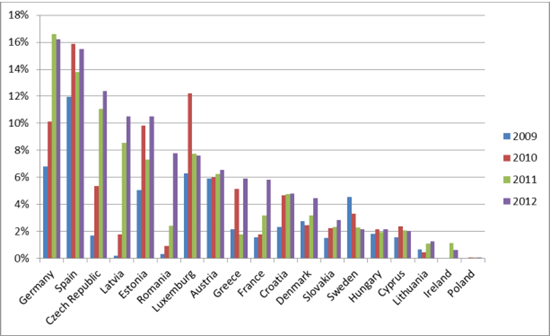 Subsidies for renewable energy as a percentage of the retail electricity price in selected European countries, 2009 to 2012.
Subsidies for renewable energy as a percentage of the retail electricity price in selected European countries, 2009 to 2012.
The UK is not included in the graph above. Renewables subsidies accounted for about seven per cent of the the retail price of electricity in 2013, according to government data – putting the UK roughly in the middle of the pack.
Electricity – UK consumers pay less than most of Europe
Despite subsidies, UK consumers still pay less than many of our European neighbours for our energy, according to the report.
The graph below compares the price households pay for electricity across the EU, with the UK in the last column:
The UK charges a low VAT rate of five per cent on domestic electricity. Some other countries charge VAT on electricity at rates as high as twenty five per cent, adding far more to the cost of energy.
Different EU countries may use different methods for identifying what a government levy or tax is and what is part of the price of energy without taxes, according to the report – so the graph above probably shouldn’t be taken as definitive.
Energy efficiency: UK homes are expensive to run, but we’re richer than others in Europe
The price of electricity and gas isn’t the only factor influencing household energy bills, as the amount of energy households consume also varies. Between 2000 and 2011, household energy consumption decreased in most EU member states – both as the result of higher prices, and more efficient use of energy.
The UK’s homes are relatively energy inefficient, compared to other European countries. But despite this, we still have lower bills than many of our neighbours. The amount spent on energy is relatively low in this country as a proportion of total household expenditure.
Southern European countries – like Spain, Cyprus and Greece – tend to spend less on energy, as they have lower heating needs, according to the report. Central and eastern European countries spend more, because the countries are colder and household incomes are lower. But richer European countries, like the UK, spend less because they have a higher disposable income.
The average household spent about four per cent of their income on energy in 2011 in the UK. This is higher than it was a decade ago – but still considerably lower than the Czech Republic, where householders spend about a tenth of their income on energy.
The graph below compares the amount of their income householders from different European countries spend on energy:
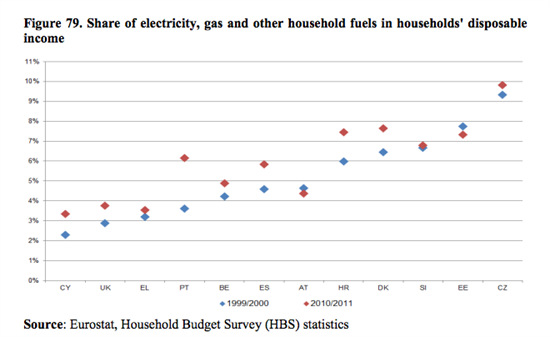 Comparing the amount households spent on energy in different European countries in 1999/2000 and 2010/11. The UK is the second from the left on the x-axis.
Comparing the amount households spent on energy in different European countries in 1999/2000 and 2010/11. The UK is the second from the left on the x-axis.
Fuel poverty: the UK does worse than countries of equivalent income
Fuel poverty is still a problem in this country. Just under ten per cent of the UK population are unable to afford to keep their homes warm, according to the data in this report.
This is far less than in many poorer European countries, including Italy, Portugal, Cyprus and Bulgaria. But it’s more than countries of equivalent income – Germany, Denmark or Sweden. The following graph, which compares fuel poverty in different European countries, illustrates this pattern – the UK is on the right:
Summary
So overall – energy prices are going up in the UK, as they are elsewhere in Europe. We appear to be spending more than many other developed European countries on encouraging a greener energy system. This is not surprising, given the country faces a significant task in ramping up renewable energy from under two percent to 15 per cent of supply in just over a decade.
We spend less on energy than many other European countries, but the affordability of energy for poorer community is still a greater problem in the UK than it is in many other rich European countries.


